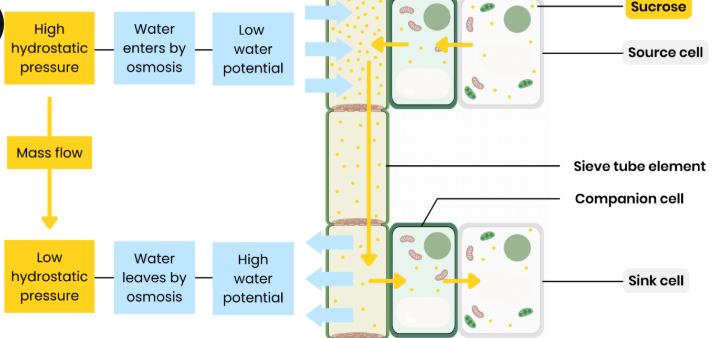3.3 Organisms exchange substances with their environment
1/84
There's no tags or description
Looks like no tags are added yet.
Name | Mastery | Learn | Test | Matching | Spaced |
|---|
No study sessions yet.
85 Terms
Describe the relationship between the size and structure of an organism and its surface area to volume ratio (SA:V)
● As size increases, SA:V tends to decrease
● More thin / flat / folded / elongated structures increase SA:V
How is SA:V calculated?
Divide surface area (size length x side width x number of sides) by volume (length x width x depth)
Suggest an advantage of calculating SA:mass for organisms instead of SA:V
Easier / quicker to find / more accurate because irregular shapes
What is metabolic rate? Suggest how it can be measured
● Metabolic rate = amount of energy used up by an organism within a given period of time
● Often measured by oxygen uptake → as used in aerobic respiration to make ATP for energy release
Explain the relationship between SA:V and metabolic rate
As SA:V increases (smaller organisms), metabolic rate increases because:
● Rate of heat loss per unit body mass increases
● So organisms need a higher rate of respiration
● To release enough heat to maintain a constant body temperature ie. replace lost heat
Explain the adaptations that facilitate exchange as SA:V reduces in larger organisms
1. Changes to body shape (eg. long / thin)
○ Increases SA:V and overcomes (reduces) long diffusion distance / pathway
2. Development of systems, such as a specialised surface / organ for gaseous exchange e.g. lungs:
○ Increases (internal) SA:V and overcomes (reduces) long diffusion distance / pathway
○ Maintain a concentration gradient for diffusion eg. by ventilation / good blood supply
Explain how the body surface of a single-celled organism is adapted for gas
exchange
● Thin, flat shape and large surface area to volume ratio
● Short diffusion distance to all parts of cell → rapid diffusion eg. of O2 / CO2
Describe the tracheal system of an insect
1. Spiracles = pores on surface that can open / close to allow diffusion
2. Tracheae = large tubes full of air that allow diffusion
3. Tracheoles = smaller branches from tracheae, permeable to allow gas exchange with cells
Explain how an insect’s tracheal system is adapted for gas exchange
● Tracheoles have thin walls
○ So short diffusion distance to cells
● High numbers of highly branched tracheoles
○ So short diffusion distance to cells
○ So large surface area
● Tracheae provide tubes full of air
○ So fast diffusion
● Contraction of abdominal muscles (abdominal
pumping) changes pressure in body, causing air to
move in / out
○ Maintains concentration gradient for diffusion
● Fluid in end of tracheoles drawn into tissues by
osmosis during exercise (lactate produced in
anaerobic respiration lowers ψ of cells)
○ As fluid is removed, air fills tracheoles
○ So rate of diffusion to gas exchange surface
increases as diffusion is faster through air
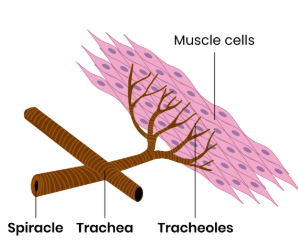
Explain structural and functional compromises in terrestrial insects that allow efficient gas exchange while limiting water loss
● Thick waxy cuticle / exoskeleton → Increases diffusion distance so less water loss (evaporation)
● Spiracles can open to allow gas exchange AND close to reduce water loss (evaporation)
● Hairs around spiracles → trap moist air, reducing ψ gradient so less water loss (evaporation)
Explain how the gills of fish are adapted for gas exchange
● Gills made of many filaments covered with many lamellae
○ Increase surface area for diffusion
● Thin lamellae wall / epithelium
○ So short diffusion distance between water / blood
● Lamellae have a large number of capillaries
○ Remove O2 and bring CO2 quickly so maintains
concentration gradient
Counter current flow:
1. Blood and water flow in opposite directions through/over lamellae
2. So oxygen concentration always higher in water (than blood near)
3. So maintains a concentration gradient of O2 between water and blood
4. For diffusion along whole length of lamellae
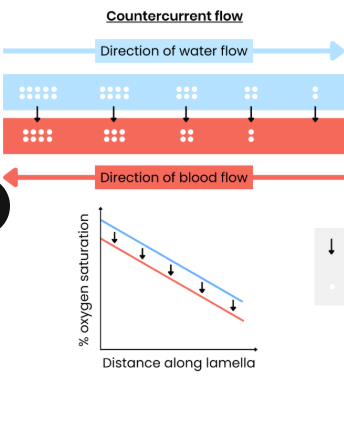
If parallel flow??
If parallel flow, equilibrium would be reached so oxygen wouldn’t diffuse into blood along the whole gill plate
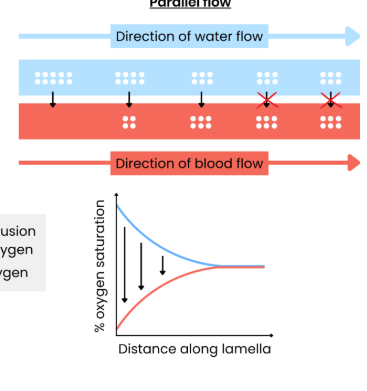
Explain how the leaves of dicotyledonous plants are adapted for gas
exchange
● Many stomata (high density) → large surface area for gas exchange (when opened by guard cells)
● Spongy mesophyll contains air spaces → large surface area for gases to diffuse through
● Thin → short diffusion distance
Xerophyte
Plant adapted to live in very dry conditions eg. Cacti and marram grass
Explain structural and functional compromises in xerophytic plants that allow efficient gas exchange while limiting water loss
● Thicker waxy cuticle
○ Increases diffusion distance so less evaporation
● Sunken stomata in pits / rolled leaves / hairs
○ ‘Trap’ water vapour / protect stomata from wind
○ So reduced water potential gradient between leaf / air
○ So less evaporation
● Spines / needles
○ Reduces surface area to volume ratio
Describe the gross structure of the human gas exchange system
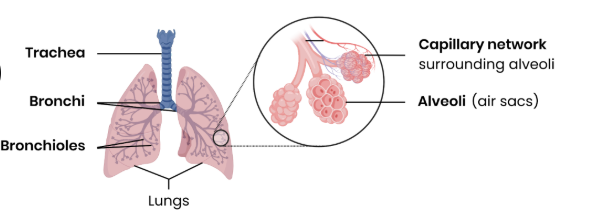
Explain the essential features of the alveolar epithelium that make it adapted as a surface for gas exchange
● Flattened cells / 1 cell thick → short diffusion distance
● Folded → large surface area
● Permeable → allows diffusion of O2 / CO2
● Moist → gases can dissolve for diffusion
● Good blood supply from large network of capillaries → maintains concentration gradient
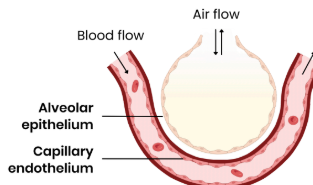
Describe how gas exchange occurs in the lungs
● Oxygen diffuses from alveolar air space into blood down its concentration gradient
● Across alveolar epithelium then across capillary endothelium
Explain the importance of ventilation
● Brings in air containing higher conc. of oxygen & removes air with lower conc. of oxygen
● Maintaining concentration gradients
Explain how humans breathe in
1. Diaphragm muscles contract → flattens
2. External intercostal muscles contract, internal intercostal muscles relax (antagonistic) → ribcage pulled up / out
3. Increasing volume and decreasing pressure (below atmospheric) in thoracic cavity
4. Air moves into lungs down pressure gradient
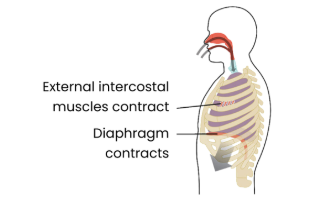
Explain how humans breathe out
1. Diaphragm relaxes → moves upwards
2. External intercostal muscles relax, internal intercostal muscles may contract → ribcage
moves down / in
3. Decreasing volume and increasing pressure (above atmospheric) in thoracic cavity
4. Air moves out of lungs down pressure gradient
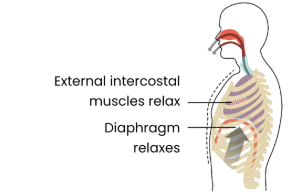
Suggest why expiration is normally passive at rest
● Internal intercostal muscles do not normally need to contract
● Expiration aided by elastic recoil in alveoli
Suggest how different lung diseases reduce the rate of gas exchange
● Thickened alveolar tissue (eg. fibrosis) → increases diffusion distance
● Alveolar wall breakdown → reduces surface area
● Reduce lung elasticity → lungs expand / recoil less → reduces concentration gradients of O2 / CO2
Suggest how different lung diseases affect ventilation
● Reduce lung elasticity (eg. fibrosis - build-up of scar tissue) → lungs expand / recoil less
Reducing volume of air in each breath (tidal volume)
Reducing maximum volume of air breathed out in one breath (forced vital capacity)
● Narrow airways / reduce airflow in & out of lungs (eg. asthma - inflamed bronchi)
Reducing maximum volume of air breathed out in 1 second (forced expiratory volume)
● Reduced rate of gas exchange → increased ventilation rate to compensate for reduced oxygen in blood
Suggest how different lung diseases affect ventilation
Suggest how different lung diseases affect ventilation
Suggest how you can analyse and interpret data to the effects of pollution, smoking and other risk factors on the incidence of lung disease
● Describe overall trend → eg. positive / negative correlation between risk factor and incidence of disease
● Manipulate data → eg. calculate percentage change
● Interpret standard deviations → overlap suggests differences in means are likely to be due to chance
● Use statistical tests → identify whether difference / correlation is significant or due to chance
○ Correlation coefficient → examining an association between 2 sets of data
○ Student’s t test → comparing means of 2 sets of data
○ Chi-squared test → for categorical data
Suggest how you can evaluate the way in which experimental data led to statutory restrictions on the sources of risk factors
● Analyse and interpret data as above and identify what does and doesn’t support statement
● Evaluate method of collecting data
○ Sample size → large enough to be representative of population?
○ Participant diversity eg. age, sex, ethnicity and health status → representative of population?
○ Control groups → used to enable comparison?
○ Control variables eg. health, previous medications → valid?
○ Duration of study → long enough to show long-term effects?
● Evaluate context → has a broad generalisation been made from a specific set of data?
● Other risk factors that could have affected results?
Explain the difference between correlations and causal relationships
● Correlation = change in one variable reflected by a change in another - identified on a scatter diagram
● Causation = change in one variable causes a change in another variable
● Correlation does not mean causation → may be other factors involved
Explain what happens in digestion
● Large (insoluble) biological molecules hydrolysed to smaller (soluble) molecules
● That are small enough be absorbed across cell membranes into blood
Describe the digestion of starch in mammals
● Amylase (produced by salivary glands / pancreas) hydrolyses starch to maltose
● Membrane-bound maltase (attached to cells lining ileum) hydrolyses maltose to glucose
● Hydrolysis of glycosidic bond

Describe the digestion of disaccharides in mammals
● Membrane-bound disaccharidases hydrolyse disaccharides to 2 monosaccharides:
○ Maltase - maltose → glucose + glucose
○ Sucrase - sucrose → fructose + glucose
○ Lactase - lactose → galactose + glucose
● Hydrolysis of glycosidic bond
Describe the digestion of lipids in mammals, including action of bile salts
● Bile salts (produced by liver) emulsify lipids causing them to form smaller lipid droplets
● This increases surface area of lipids for increased / faster lipase activity
● Lipase (made in pancreas) hydrolyses lipids (eg. triglycerides) → monoglycerides + fatty acids
● Hydrolysis of ester bond

Describe the digestion of proteins by a mammal
● Endopeptidases - hydrolyse internal (peptide) bonds within a polypeptide → smaller peptides
○ So more ends / surface area for exopeptidases
● Exopeptidases - hydrolyse terminal (peptide) bonds at ends of polypeptide → single amino acids
● Membrane-bound dipeptidases - hydrolyse (peptide) bond between a dipeptide → 2 amino acids
● Hydrolysis of peptide bond
Suggest why membrane-bound enzymes are important in digestion
● Membrane-bound enzymes are located on cell membranes of epithelial cells lining ileum
● (By hydrolysing molecules at the site of absorption they) maintain concentration gradients for absorption
Describe the pathway for absorption of products of digestion in mammals
Lumen (inside) of ileum → cells lining ileum (part of small intestine) → blood
Describe the absorption of amino acids and monosaccharides in mammals
1:
● Na+ actively transported from epithelial cells lining ileum to blood (by Na+/K+ pump)
● Establishing a concentration gradient of Na+ (higher in lumen than epithelial cell)
2:
● Na+ enters epithelial cell down its concentration gradient with monosaccharide or amino acid against its concentration gradient
● Via a co-transporter protein
3:
● Monosaccharide or amino acid moves down a concentration gradient in to blood via facilitated diffusion
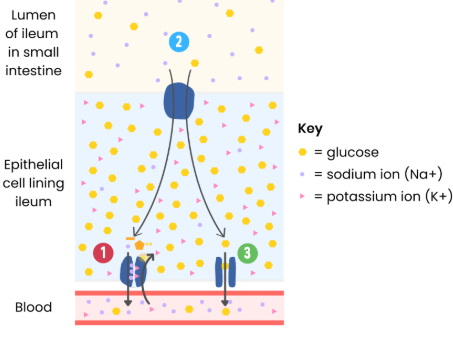
Describe the absorption of lipids by a mammal, including the role of micelles
Micelles contain bile salts and fatty acids/monoglycerides; Bring/release/carry fatty acids/monoglycerides to cell/lining (of the iluem); Fatty acids/monoglycerides absorbed by diffusion; Triglycerides (re)formed (in cells); * Vesicles move to cell membrane OR exocytosis;
Describe the role of red blood cells & haemoglobin (Hb) in oxygen transport
● Red blood cells contain lots of Hb
○ No nucleus & biconcave → more space for Hb, high SA:V & short diffusion distance
● Hb associates with / binds / loads oxygenat gas exchange surfaces (lungs) where partial
pressure of oxygen (pO2) is high
● This forms oxyhaemoglobin which transports oxygen
○ Each can carry four oxygen molecule, one at each Haem group
● Hb dissociates from / unloads oxygen near cells / tissues where pO2
is low
Describe the structure of haemoglobin
● Protein with a quaternary structure
● Made of 4 polypeptide chains
● Each chain contains a Haem group containing an iron ion (Fe
The haemoglobins are a group of chemically similar molecules found in many different organisms
Describe the loading, transport and unloading of oxygen in relation to the
oxyhaemoglobin dissociation curve (Areas with low pO2 - respiring tissues)
● Hb has a low affinity for oxygen
● So oxygenreadily unloads / dissociates with Hb
● So % saturation is low
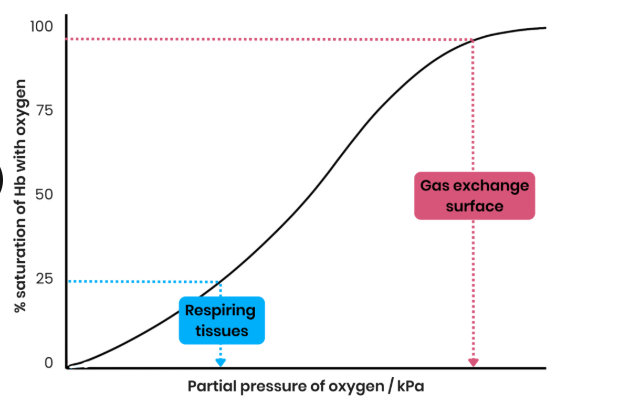
Describe the loading, transport and unloading of oxygen in relation to the
oxyhaemoglobin dissociation curve (Areas with high pO2 - gas exchange surfaces)
● Hb has a high affinity for oxygen
● So oxygenreadily loads / associates with Hb
● So % saturation is high

Explain how the cooperative nature of oxygen binding results in an S-shaped (sigmoid) oxyhaemoglobin dissociation curve
1. Binding of first oxygen changes tertiary / quaternary structure of haemoglobin
2. This uncovers Haem group binding sites, making further binding of oxygens easier
Describe evidence for the cooperative nature of oxygen binding
● A low pO2 as oxygen increases there is little / slow increase in % saturation of Hb with oxygen
○ When first oxygen is binding
● At higher pO2, as oxygen increases there is a big / rapid increase in % saturation of Hb with oxygen
○ Showing it has got easier for oxygens to bind
What is the Bohr effect?
Effect of CO2 concentration on dissociation of oxyhaemoglobin → curve shifts to right
Explain effect of CO2 concentration on the dissociation of oxyhaemoglobin
1. Increasing blood CO2 eg. due to increased rate of respiration
2. Lowers blood pH (more acidic)
3. Reducing Hb’s affinity for oxygen as shape / tertiary / quaternary structure changes slightly
4. So more / faster unloading of oxygen to respiring cells at a given pO2

Describe evidence for the Bohr effect
At a given pO2 %, the saturation of Hb with oxygen is lower
Explain the advantage of the Bohr effect (eg. during exercise)
More dissociation of oxygen → faster aerobic respiration / less anaerobic respiration → more ATP produced
Explain why different types of haemoglobin can have different oxygen transport properties
● Different types of Hb are made of polypeptide chains with slightly different amino acid sequences
● Resulting in different tertiary / quaternary structures / shape
● So they have different affinities for oxygen
Explain how organisms can be adapted to their environment by having different types of haemoglobin with different oxygen transport properties (Curve shift left, Hb has higher affinity for O2)
● More O2 associates with Hb more readily
● At gas exchange surfaces where pO2 is lower
● Eg. organisms in low O2 environments - high altitudes, underground, or foetuses

Explain how organisms can be adapted to their environment by having different types of haemoglobin with different oxygen transport properties (Curve shift right, Hb has lower affinity for O2)
● More O2 dissociates from Hb more readily
● At respiring tissues where more O2 is needed
● Eg. organisms with high rates of respiration /metabolic rate (may be small or active)
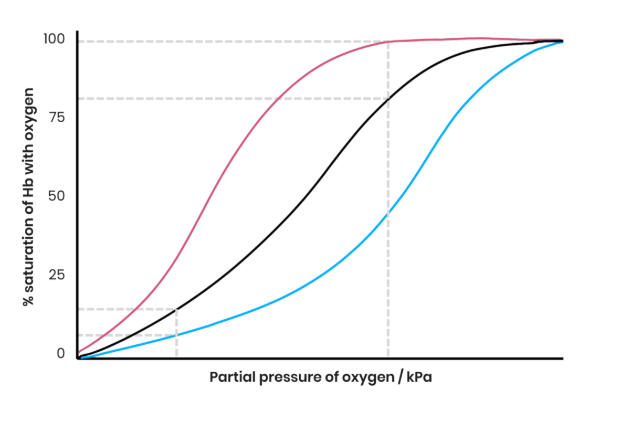
Describe the general pattern of blood circulation in a mammal
Closed double circulatory system - blood passes through heart twice for every circuit around body:
1. Deoxygenated blood in right side of heart pumped to lungs; oxygenated returns to left side
2. Oxygenated blood in left side of heart pumped to rest of body; deoxygenated returns to right
Suggest the importance of a double circulatory system
● Prevents mixing of oxygenated / deoxygenated blood
○ So blood pumped to body is fully saturated with oxygen for aerobic respiration
● Blood can be pumped to body at a higher pressure (after being lower from lungs)
○ Substances taken to / removed from body cells quicker / more efficiently
Draw a diagram to show the general pattern of blood circulation in a mammal, including the names of key blood vessels
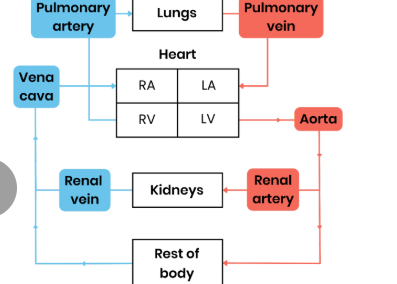
Name the blood vessels entering and leaving the heart and lungs (heart)
● Vena cava – transports deoxygenated blood from respiring body tissues → heart
● Pulmonary vein – transports oxygenated blood from lungs → heart
Name the blood vessels entering and leaving the heart and lungs (leaving)
● Pulmonary artery – transports deoxygenated blood from heart → lungs
● Aorta – transports oxygenated blood from heart → respiring body tissues
Name the blood vessels entering and leaving the kidneys
● Renal arteries – oxygenated blood → kidneys
● Renal veins – deoxygenated blood to vena cava from kidneys
Name the the blood vessels that carry oxygenated blood to the heart muscle
Coronary arteries - located on surface of the heart, branching from aorta
Label a diagram to show the gross structure of the human heart (inside)
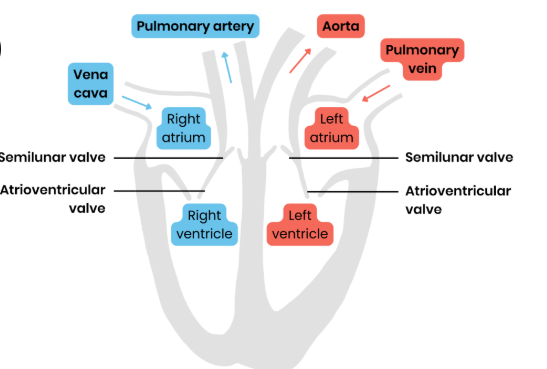
Suggest why the wall of the left ventricle is thicker than that of the right
● Thicker muscle to contract with greater force
● To generate higher pressure to pump blood around entire body
Explain the pressure & volume changes and associated valve movements during the cardiac cycle that maintain a unidirectional flow of blood (Atrial systole)
● Atria contract
● So their volume decreases, pressure increases
● Atrioventricular valves open when pressure in atria exceeds pressure in ventricles
● Semilunar valves remain shut as pressure in arteries exceeds pressure in ventricles
● So blood pushed into ventricles
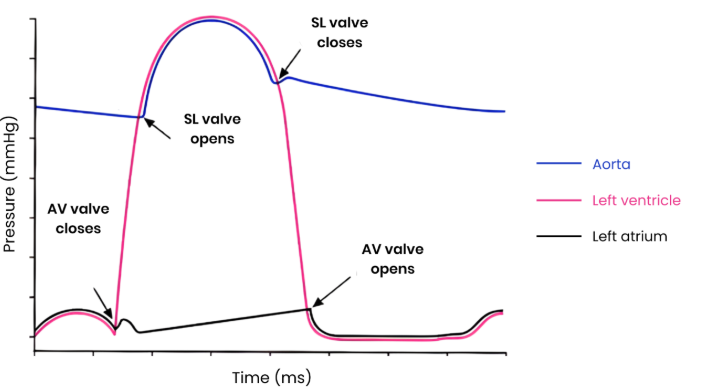
Explain the pressure & volume changes and associated valve movements during the cardiac cycle that maintain a unidirectional flow of blood (Ventricular systole)
● Ventricles contract
● So their volume decreases, pressure increases
● Atrioventricular valves shut when pressure in ventricles exceeds pressure in atria
● Semilunar valves open when pressure in ventricles exceeds pressure in arteries
● So blood pushed out of heart through arteries
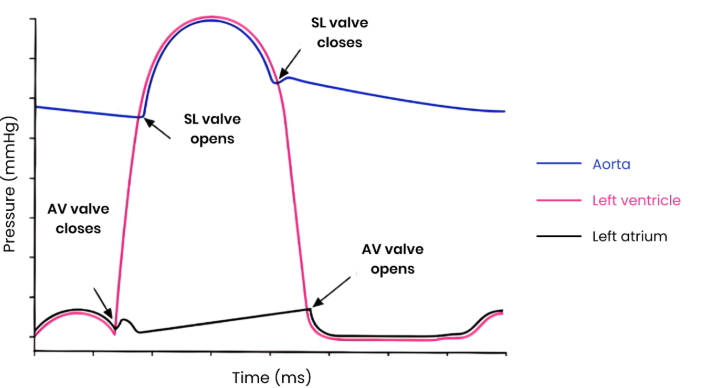
Explain the pressure & volume changes and associated valve movements during the cardiac cycle that maintain a unidirectional flow of blood (Disastole)
● Atria & ventricles relax
● So their volume increases, pressure decreases
● Semilunar valves shut when pressure in arteries exceeds pressure in ventricles
● Atrioventricular valves open when pressure in atria exceeds pressure in ventricles
● So blood fills atria via veins & flows passively to ventricles
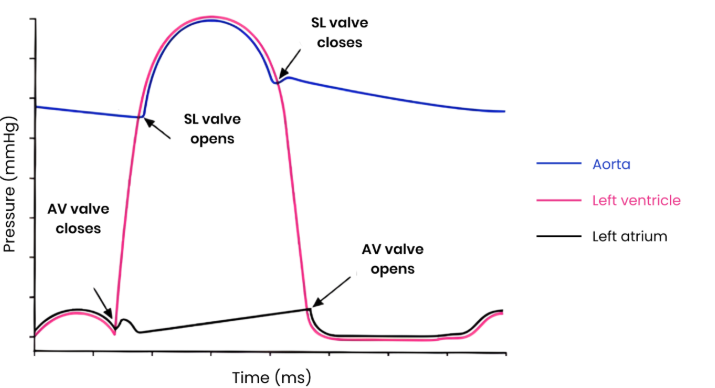
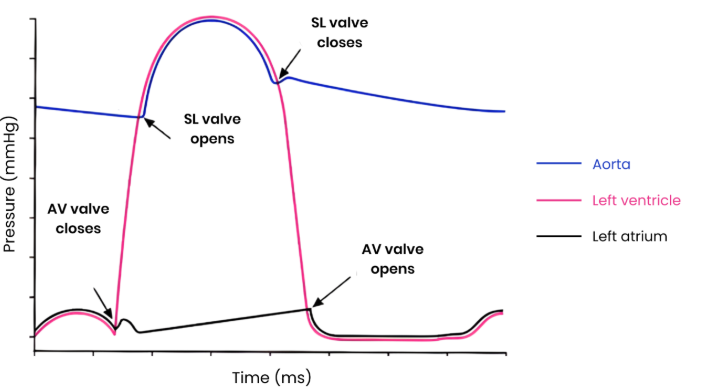
Explain how graphs showing pressure or volume changes during the cardiac
cycle can be interpreted, eg. to identify when valves are open / closed
Semilunar valves closed:
● Pressure in [named] artery higher than in ventricle
● To prevent backflow of blood from artery to ventricles
Semilunar valves open:
● When pressure in ventricle is higher than in [named] artery
● So blood flows from ventricle to artery
Atrioventricular valves closed:
● Pressure in ventricle higher than atrium
● To prevent backflow of blood from ventricles to atrium
Atrioventricular valves open:
● When pressure in atrium is higher than in ventricle
● So blood flows from atrium to ventricle
![<ul><li><p>Semilunar valves closed:</p><p></p></li></ul><p>● Pressure in [named] artery higher than in ventricle</p><p>● To prevent backflow of blood from artery to ventricles</p><ul><li><p>Semilunar valves open:</p><p></p></li></ul><p>● When pressure in ventricle is higher than in [named] artery</p><p>● So blood flows from ventricle to artery</p><ul><li><p>Atrioventricular valves closed:</p><p></p></li></ul><p>● Pressure in ventricle higher than atrium</p><p>● To prevent backflow of blood from ventricles to atrium</p><ul><li><p>Atrioventricular valves open:</p><p></p></li></ul><p>● When pressure in atrium is higher than in ventricle</p><p>● So blood flows from atrium to ventricle</p>](https://knowt-user-attachments.s3.amazonaws.com/4adf70fa-e3a5-45ba-b039-8ab45959bb2d.png)
How can heart rate be calculated from cardiac cycle data?
Heart rate (beats per minute) = 60 (seconds) / length of one cardiac cycle (seconds)
Describe the equation for cardiac output
Cardiac output (volume of blood pumped out of heart per min) = stroke volume (volume of blood pumped in each heart beat) x heart rate (number of beats per min)
Explain how the structure of arteries relates to their function (carry blood away from heart at high pressure)
Thick smooth muscle tissue: Can contract and control / maintain / withstand blood flow / pressure
Thick elastic tissue: Can stretch as ventricles contract and recoil as ventricles relax, to reduce pressure surges / even out blood pressure / maintain high pressure
Thick wall: Withstands high pressure / prevents bursting
Smooth / folded endothelium: Reduces friction / can stretch
Narrow lumen: Increases / maintains high pressure
Explain how the structure of arterioles relates to their function (division of arteries to smaller vessels which can) direct blood to different capillaries / tissues
● Thicker smooth muscle layer than arteries
○ Contracts → narrows lumen (vasoconstriction) → reduces blood flow to capillaries
○ Relaxes → widens lumen (vasodilation) → increases blood flow to capillaries
● Thinner elastic layer → pressure surges are lower (as further from heart / ventricles)
Explain how the structure of capillaries relates to their function (allow efficient exchange of substances between blood and tissue fluid)
Wall is a thin (one cell) layer of endothelial cells: Reduces diffusion distance
Capillary bed - large network of branched capillaries: Increases surface area for diffusion
Small diameter / narrow lumen: Reduces blood flow rate so more time for diffusion
Pores in walls between cells: Allow larger substances through
Explain how the structure of veins relates to their function (carry blood back to heart at lower pressure)
● Wider lumen than arteries → less resistance to blood flow
● Very little elastic and muscle tissue → blood pressure lower
● Valves → prevent backflow of blood
Explain the formation of tissue fluid
At the arteriole end of capillaries:
1. Higher blood / hydrostatic pressure inside capillaries (due to contraction of ventricles) than tissue fluid (so net outward force)
2. Forcing water (and dissolved substances) out of capillaries
3. Large plasma proteins remain in capillary
Explain the return of tissue fluid to the circulatory system
At the venule end of capillaries:
1. Hydrostatic pressure reduces as fluid leaves capillary (also due to friction)
2. (Due to water loss) an increasing concentration of plasma proteins lowers water potential in capillary below that of tissue fluid)
3. Water enters capillaries from tissue fluid by osmosis down a water potential gradient
4. Excess water taken up by lymph capillaries and returned to circulatory system through veins
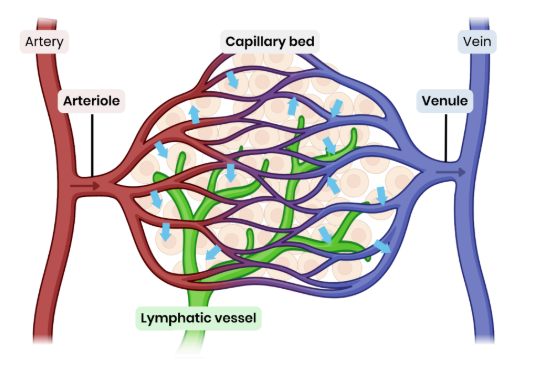
Suggest and explain causes of excess tissue fluid accumulation
● Low concentration of protein in blood plasma
○ Water potential in capillary not as low → water potential gradient is reduced
○ So more tissue fluid formed at arteriole end / less water absorbed at venule end by osmosis
○ Lymph system may not be able to drain excess fast enough
● High blood pressure (eg. caused by high salt concentration) → high hydrostatic pressure
○ Increases outward pressure from arteriole end AND reduces inward pressure at venule end
○ So more tissue fluid formed at arteriole end / less water absorbed at venule end by osmosis
○ Lymph system may not be able to drain excess fast enough
What is a risk factor? Give examples for cardiovascular disease
● An aspect of a person’s lifestyle or substances in a person’s body / environment
● That have been shown to be linked to an increased rate of disease
● Examples - age, diet high in salt or saturated fat, smoking, lack of exercise, genes
Describe the function of xylem tissue
Transports water (and mineral ions) through the stem, up the plant to leaves of plants
Suggest how xylem tissue is adapted for its function
● Cells joined with no end walls forming a long continuous tube → water flows as a continuous column
● Cells contain no cytoplasm / nucleus → easier water flow / no obstructions
● Thick cell walls with lignin → provides support / withstand tension / prevents water loss
● Pits in side walls → allow lateral water movements
Explain the cohesion-tension theory of water transport in the xylem
Leaf:
1. Water lost from leaf by transpiration - water evaporates from mesophyll cells into air spaces and water vapour diffuses through (open) stomata
2. Reducing water potential of mesophyll cells
3. So water drawn out of xylem down a water potential gradient
Xylem:
4. Creating tension (‘negative pressure’ or ‘pull’) in xylem
5. Hydrogen bonds result in cohesion between water molecules (stick together) so water is pulled up as a continuous column
6. Water also adheres (sticks to) to walls of xylem
Root
7. Water enters roots via osmosis
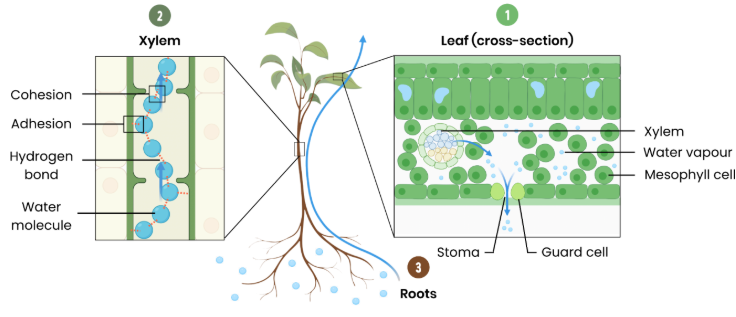
Suggest how Light intensity affect transpiration rate
As light intensity increases it Increases rate of transpiration because:
● Stomata open in light to let in CO2
for photosynthesis
● Allowing more water to evaporate faster
● Stomata close when it’s dark so there is a low transpiration rate
Suggest how temperature affect transpiration rate
As temperature increases it Increases rate of transpiration because:
● Water molecules gain kinetic energy as temperature increases
● So water evaporates faster
Suggest how Wind intensity affect transpiration rate
As Wind intensity increases it Increases rate of transpiration because:
● Wind blows away water molecules from around stomata
● Decreasing water potential of air around stomata
● Increasing water potential gradient so water evaporates faster
Suggest how Humidity affect transpiration rate
As humidity increases it decreases rate of transpiration because:
● More water in air so it has a higher water potential
● Decreasing water potential gradient from leaf to air
● Water evaporates slower
Describe the function of phloem tissue
Transports organic substances eg. sucrose in plants
Suggest how phloem tissue is adapted for its function
1. Sieve tube elements
○ No nucleus / few organelles → maximise space for / easier flow of organic substances
○ End walls between cells perforated (sieve plate)
2. Companion cells
○ Many mitochondria → high rate of respiration to make ATP for active transport of solutes
What is translocation?
● Movement of assimilates / solutes such as sucrose
● From source cells (where made, eg. leaves) to sink cells (where used / stored, eg. roots) by mass flow
Explain the mass flow hypothesis for translocation in plants
1. At source, sucrose is actively transported into phloem sieve tubes / cells
2. By companion cells
3. This lowers water potential in sieve tubes so water enters (from xylem) by osmosis
4. This increases hydrostatic pressure in sieve tubes (at source) / creates a hydrostatic pressure gradient
5. So mass flow occurs - movement from source to sink
6. At sink, sucrose is removed by active transport to be used by respiring cells or stored in storage organs
